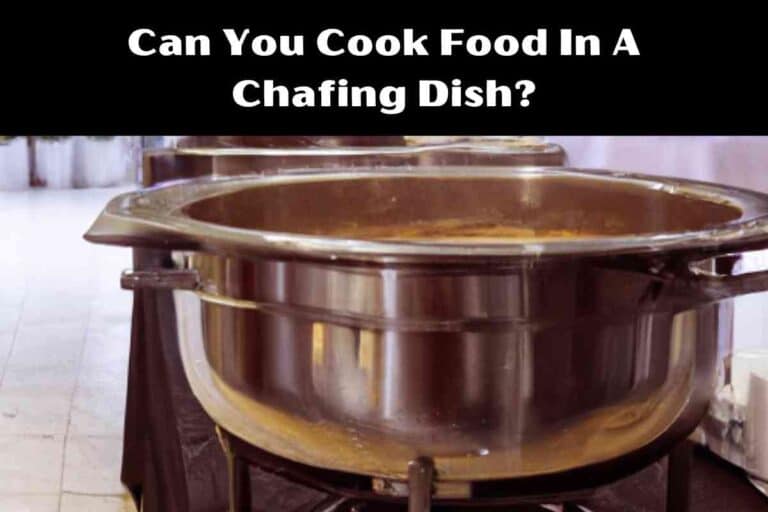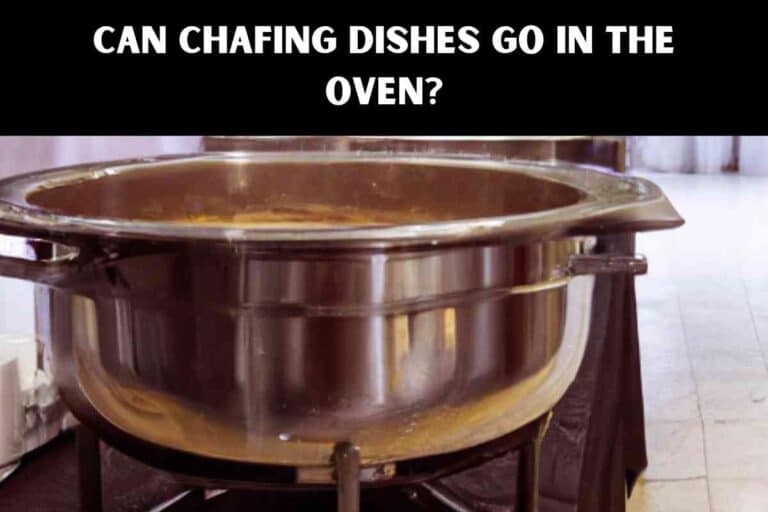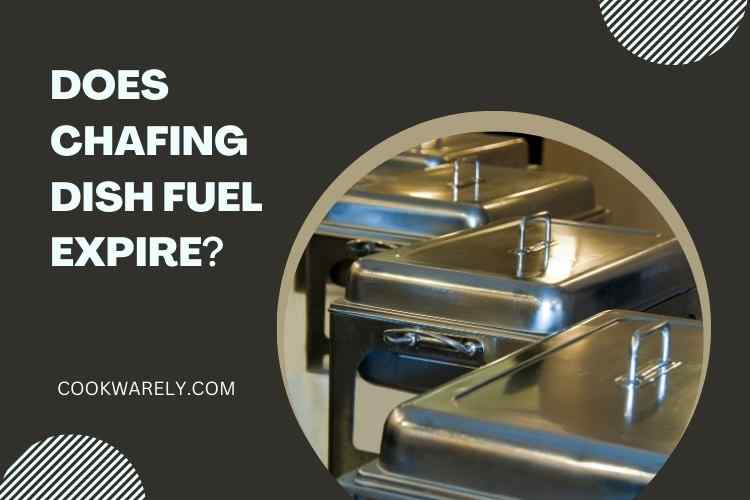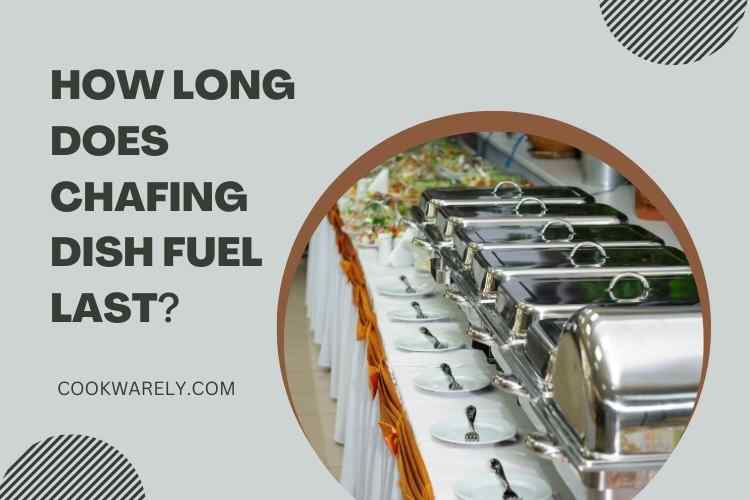How Long Can Food Stay in Chafing Dish?
If you’ve ever hosted a party or catered an event, you know the hassle of keeping warm food while mingling and socializing.
How Long Can Food Stay in Chafing Dish? The duration for which food can safely remain in a chafing dish depends on various factors, including the type of food, ambient temperature, and proper maintenance of temperature control. As a general guideline, perishable food should not be kept in a chafing dish for more than two hours to prevent the growth of harmful bacteria.
It is crucial to monitor and maintain the internal temperature of the food above 140°F (60°C) to ensure food safety. After the recommended time, any remaining food should be promptly discarded to minimize the risk of foodborne illnesses.
These large, rectangular containers are designed to hold and keep food warm over a long period, making them a popular choice for buffets, brunches, and other events where food needs to be served for an extended period.
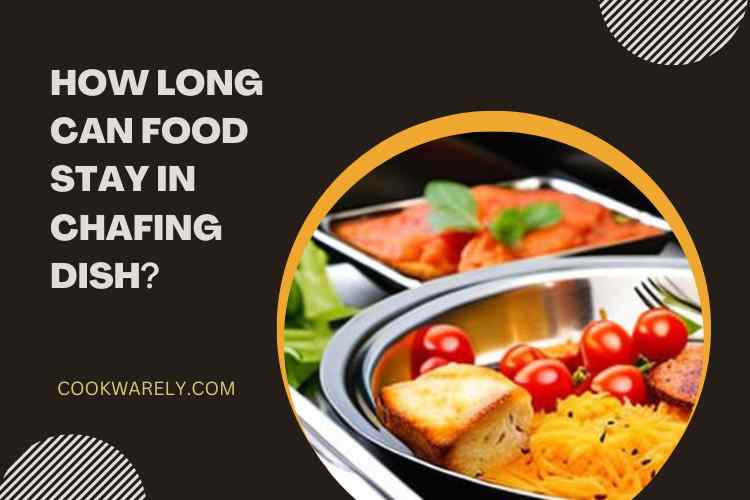
But as convenient as chafing dishes are, they come with a few considerations regarding food safety. Namely, how long can food stay in a chafing dish without going bad?
In this article, we’ll dive into the factors that affect how long food can stay in a chafing dish, as well as offer some tips for keeping your food safe and delicious for as long as possible.
Factors That Affect How Long Food Can Stay in a Chafing Dish
A few key factors can affect how long food can stay in a chafing dish. These include:
1. type of food
Some foods are more perishable than others, so they won’t last as long in a chafing dish. For example, raw meats, poultry, and seafood should be kept at a safe temperature to prevent bacterial growth.
These foods should not be left in a chafing dish for more than two hours. On the other hand, cooked grains, pasta, and root vegetables can generally be left in a chafing dish for up to four hours.
2. temperature of the chafing dish
A chafing dish is designed to keep food at a safe and consistent temperature, but it’s important to ensure that the temperature is not too high or too low.
If the temperature is too high, it can cause food to dry out or even burn. If the temperature is too low, it can lead to bacterial growth.
In general, it’s best to keep the temperature of the chafing dish between 140-160°F.
3. Type of chafing dish
There are various chafing dishes, including electric, gel fuel, and Sterno fuel. Electric chafing dishes are generally the most consistent and reliable, as they use a heating element to keep the food at a consistent temperature.
Gel fuel chafing dishes are also a good option, as the gel fuel burns slowly and steadily, providing a consistent heat source.
Sterno fuel chafing dishes, on the other hand, can be more finicky, as the heat source is a small can of fuel that needs to be constantly monitored and replenished.
4. size of the chafing dish:
The larger the chafing dish, the longer the food will stay warm. This is because the larger surface area allows for more even heat distribution, which helps to keep the food at a consistent temperature.
Tips for Keeping Food Safe and Delicious in a Chafing Dish
Now that we’ve covered the factors that affect how long food can stay in a chafing dish let’s delve into some tips for keeping your food safe and delicious for as long as possible.
- Use a thermometer: To ensure that the temperature of your chafing dish is in the safe range, it’s a good idea to use a thermometer. This will help you to keep the temperature at a consistent level, which is essential for food safety. Place the thermometer in the center of the chafing dish to get an accurate reading.
- Keep hot foods hot and cold foods cold: This may seem obvious, but it’s important to remember that perishable foods should be kept at the appropriate temperature to prevent bacterial growth. Keep hot foods hot by placing them in a chafing dish that is set to the correct temperature, and keep cold foods cold by storing them in a separate chafing dish or on ice.
- Avoid overloading the chafing dish: It’s tempting to fill a chafing dish to the brim with food, but this can cause the food to lose heat more quickly. Instead, leave some space between the food and the sides of the chafing dish to allow for better heat circulation.
- Use a water pan: Many chafing dishes have a water pan underneath the food pan. This helps to regulate the temperature of the chafing dish and prevent the food from drying out. Ensure the water pan is filled with hot water to maintain a consistent temperature.
- Keep the lid closed: Chafing dishes often come with a lid to help keep the heat in and prevent bacteria from entering the food. Keep the lid closed as much as possible to maintain a consistent temperature and protect the food.
How to Store Leftover Food From a Chafing Dish?
So, you’ve hosted a successful event and now you’re left with a bunch of leftover food. What do you do? Here are some tips for storing leftover food from a chafing dish:
- Divide the food into smaller portions: It’s generally easier to store and reheat smaller portions of food, so consider dividing the leftovers into smaller containers. This will also help to prevent waste, as you can easily pull out just what you need for a quick meal.
- Use airtight containers: To keep the food fresh and prevent bacterial growth, it’s important to use airtight containers to store leftover food from a chafing dish. This will also help to keep the food from drying out.
- Label and date the containers: It’s easy to forget how long food has been in the fridge, especially if you have a lot of leftovers. Make sure to label and date the containers so you know how long the food has been stored.
- Eat leftovers within 3-4 days: While it’s generally safe to eat leftovers within 3-4 days, this will depend on the type of food and how it was stored. Use your best judgment, and if the food looks or smells off, it’s best to throw it out.
Reheating Leftover Food From a Chafing Dish
If you decide to eat leftover food from a chafing dish, it’s important to reheat it properly to ensure it is safe to eat. Here are some tips for reheating leftover food:
Use a microwave or stovetop:
The microwave is generally the quickest and easiest way to reheat leftover food, but you can also use a stovetop. Just make sure to use medium-low heat and stir the food occasionally to ensure that it heats evenly.
Bring the food to a safe temperature:
To ensure that it is safe to eat, it’s important to bring it to a safe temperature. For most foods, this means reheating to an internal temperature of at least 165°F. Use a food thermometer to check the temperature of the food.
Avoid reheating certain foods:
Some foods are unsafe to reheat, as they can contaminate or spoil easily. These include:
Raw or undercooked meats, poultry, and seafood:
These should be cooked to a safe temperature before being eaten, as they can harbor harmful bacteria that can cause food poisoning.
Soft cheeses:
These can spoil easily and should be discarded if left out for an extended period.
Egg-based dishes:
These can become contaminated if left out for too long and should be discarded if they have been in the chafing dish for more than two hours.
Foods that have been sitting out for an extended time:
If food has been left out for more than two hours, it’s best to discard it to prevent the risk of food poisoning.
How Long Do Sternos Last?
Sternos typically last for about 2 to 3 hours, depending on the brand and size. However, it’s always a good idea to check the packaging or instructions for specific guidelines.
How Long Does It Take to Heat Food with Sterno?
The heating time with sterno can vary depending on the quantity and type of food being heated, but generally, it takes around 20 to 30 minutes to heat food thoroughly using sterno.
How to Keep Catered Food Warm?
To keep catered food warm, you can use chafing dishes with sternos, which provide consistent heat. Additionally, insulating the dishes with aluminum foil and placing them in warmers or hot boxes can help maintain the desired temperature.
How Long Can Food Stay out?
Ideally, perishable food should not be left out at room temperature for more than 2 hours. After that, the risk of bacterial growth increases significantly. It’s important to refrigerate or properly store food to ensure its safety.
Conclusion
In conclusion, the length of time that food can stay in a chafing dish depends on various factors, including the type of food, the temperature of the chafing dish, the type of chafing dish, and the size of the chafing dish.
To keep food safe and delicious, it’s important to use a thermometer to ensure that the temperature is consistent, keep hot and cold foods cold, avoid overloading the chafing dish, use a water pan, and keep the lid closed as much as possible.
When storing and reheating leftover food from a chafing dish, it’s important to use airtight containers, label and date the containers, eat leftovers within 3-4 days, and reheat the food to a safe temperature using a microwave or stovetop.
By following these tips, you can enjoy delicious, safe food from your chafing dish for as long as possible.

